
Water skiing is a surface water sport in which an individual is pulled behind a boat or a cable ski installation over a body of water, skimming the surface on two skis or one ski. The sport requires sufficient area on a stretch of water, one or two skis, a tow boat with tow rope, two or three people, and a personal flotation device. In addition, the skier must have adequate upper and lower body strength, muscular endurance, and good balance.
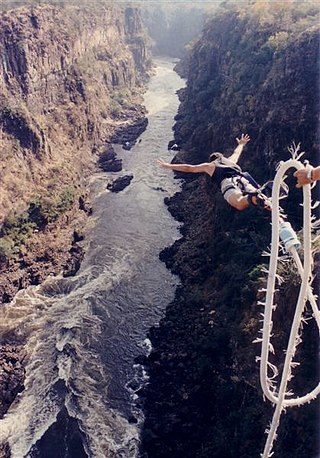
Bungee jumping, also spelled bungy jumping, is an activity that involves a person jumping from a great height while connected to a large elastic cord. The launching pad is usually erected on a tall structure such as a building or crane, a bridge across a deep ravine, or on a natural geographic feature such as a cliff. It is also possible to jump from a type of aircraft that has the ability to hover above the ground, such as a hot-air-balloon or helicopter. The thrill comes from the free-falling and the rebound. When the person jumps, the cord stretches and the jumper flies upwards again as the cord recoils, and continues to oscillate up and down until all the kinetic energy is dissipated.
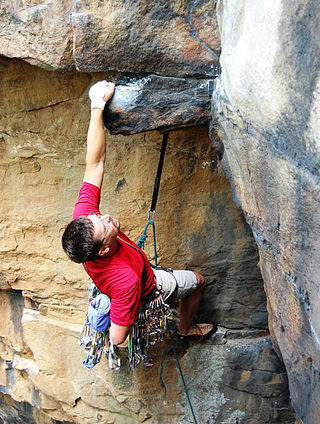
Traditional climbing is a style of rock climbing in which the climber places all the necessary protection gear required to arrest any falls as they are climbing, and then removes it when the pitch is complete. Traditional bolted aid climbing means the bolts were placed while on lead and/or with hand drills. Traditional climbing carries a higher level of risk than bolted sport climbing, as the climber may not have placed the safety equipment correctly while trying to ascend the route, or – in some cases – there may be no protection available to keep a climber from a ground fall or serious injury. For some of the world's hardest climbs, there may not be sufficient cracks or features in the rock that can accept protection gear, and the climb can only be safely attempted by bolting as a sport climb.

This glossary of climbing terms is a list of definitions of terms and jargon related to rock climbing and mountaineering. The specific terms used can vary considerably between different English-speaking countries; many of the phrases described here are particular to the United States and the United Kingdom.
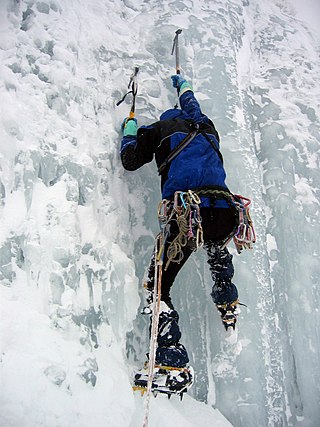
Ice climbing is the activity of ascending inclined ice formations. Usually, ice climbing refers to roped and protected climbing of features such as icefalls, frozen waterfalls, and cliffs and rock slabs covered with ice refrozen from flows of water.

A skipping rope or jump rope is a tool used in the sport of skipping/jump rope where one or more participants jump over a rope swung so that it passes under their feet and over their heads. There are multiple subsets of skipping/jump rope, including single freestyle, single speed, pairs, three-person speed, and three-person freestyle.

Solo climbing, or soloing, is a style of climbing in which the climber climbs alone, without the assistance of a belayer. By its very nature, it presents a higher degree of risk to the climber, and in some cases, is considered extremely high risk. Note that the use of the term "solo climbing" is generally separate from the action of bouldering, which is itself a form of solo climbing, but with less serious consequences in the case of a fall.

Sport climbing is a form of rock climbing that relies on permanent anchors, permanently fixed into the rock for climber protection, in which a rope that is attached to the climber is clipped into the anchors to arrest a fall; it can also involve climbing short distances with a crash pad underneath as protection. This is in contrast to traditional climbing where climbers must place removable protection as they climb. Sport climbing usually involves lead climbing and toproping techniques, but free solo and deep-water solo climbing on sport routes is also sometimes possible.
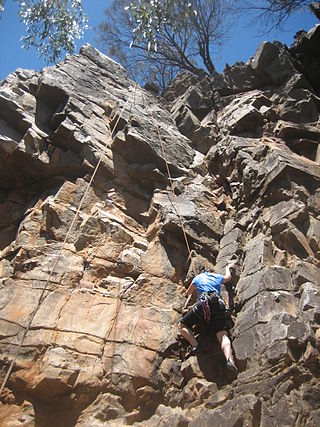
Top rope climbing is a style in climbing in which the climber is securely attached to a rope which then passes up, through an anchor system at the top of the climb, and down to a belayer at the foot of the climb. The belayer takes in slack rope throughout the climb, so that if at any point the climber were to lose their hold, they would not fall more than a short distance.
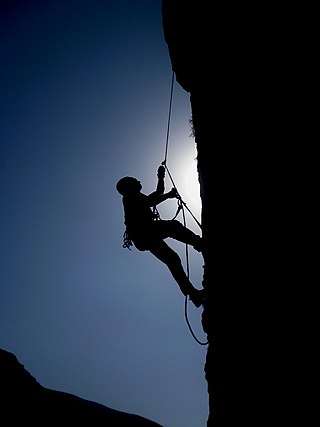
Rock climbing is a sport in which participants climb up, across, or down natural rock formations. The goal is to reach the summit of a formation or the endpoint of a usually pre-defined route without falling. Rock climbing is a physically and mentally demanding sport, one that often tests a climber's strength, endurance, agility and balance along with mental control. Knowledge of proper climbing techniques and the use of specialized climbing equipment is crucial for the safe completion of routes.

Slacklining refers to the act of walking, running or balancing along a suspended length of flat webbing that is tensioned between two anchors. Slacklining is similar to slack rope walking and tightrope walking. Slacklines differ from tightwires and tightropes in the type of material used and the amount of tension applied during use. Slacklines are tensioned significantly less than tightropes or tightwires in order to create a dynamic line which will stretch and bounce like a long and narrow trampoline. Tension can be adjusted to suit the user, and different webbing may be used in various circumstances.
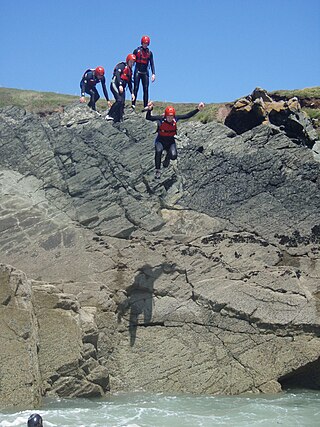
Cliff jumping is jumping off a cliff as a form of sport. When done without equipment, it may be also known as tombstoning. It forms part of the sport of coastal exploration or "coasteering". When performed with a parachute, it is known as BASE jumping. The world record for cliff jumping is currently held by Laso Schaller, with a jump of 58.8 m (193 ft).
Daniel Eugene Osman was an American extreme sport practitioner, known for the dangerous sport of free-soloing, rock climbing without ropes or other safety gear. He participated in rope jumping, falling several hundred feet from a cliff then being caught by a safety rope, for which his record was over 1,000 feet (300 m).
In rock climbing, an anchor can be any device or method for attaching a climber, a rope, or a load above or onto a climbing surface—typically rock, ice, steep dirt, or a building—either permanently or temporarily. The intention of an anchor is case-specific but is usually for fall protection, primarily fall arrest and fall restraint. Climbing anchors are also used for hoisting, holding static loads, or redirecting a rope.

Double Dutch is a game in which two long jump ropes turning in opposite directions are jumped by one or more players jumping simultaneously. It is believed to have originated among Dutch immigrants in New York City, although it has been a popular school playground game for much longer than that in the Netherlands, and is now popular worldwide. While it had long been a popular street activity for African American girls in New York City, the modern sport of Double Dutch originated in the early 1970s with NYPD officers Ulysses Williams and David Walker, who formalized the rules for competition. The first official competition was held in 1974. Competitions in Double Dutch range from block parties to the world level. During the spring of 2009, Double Dutch became a varsity sport in New York City public high schools.

High diving is the act of diving into water from relatively great heights. High diving can be performed as an adventure sport, as a performance stunt, or competitively during sporting events.
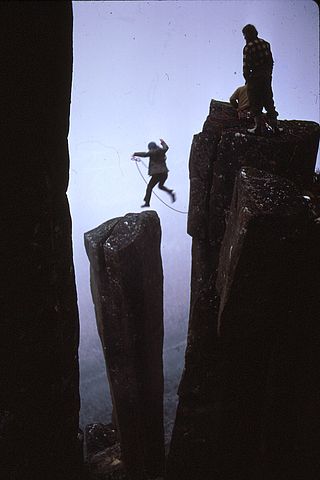
Rock Hopping is an activity involving jumping from rock to rock. The most common form of this activity is probably traveling up a boulder-filled stream or brook by jumping from rock to rock, while avoiding falling in. Another common site for rock hopping is boulder fields. Rock hopping can be used as a means of getting from one place to another in combination with scrambling over rocks for the purpose of outdoor activity such as rock climbing. It has also become an extreme sport whereby participants jump over large gaps, sometimes without any form of safety device such as a securing rope to ensure they do not fall and injure themselves or worse.

Ski-BASE jumping is the recreational sport of skiing at a high speed off of a cliff or mountain and free-falling through the air, using a parachute to descend to the ground, therefore combining the two sports of skiing and BASE jumping. Participants often perform tricks or manoeuvres during the freefall and remove their skis mid-air in order to safely deploy the parachute and land.
The International Jump Rope Union (IJRU) is the highest authority and world governing body for the sport of jump roping and rope skipping.















